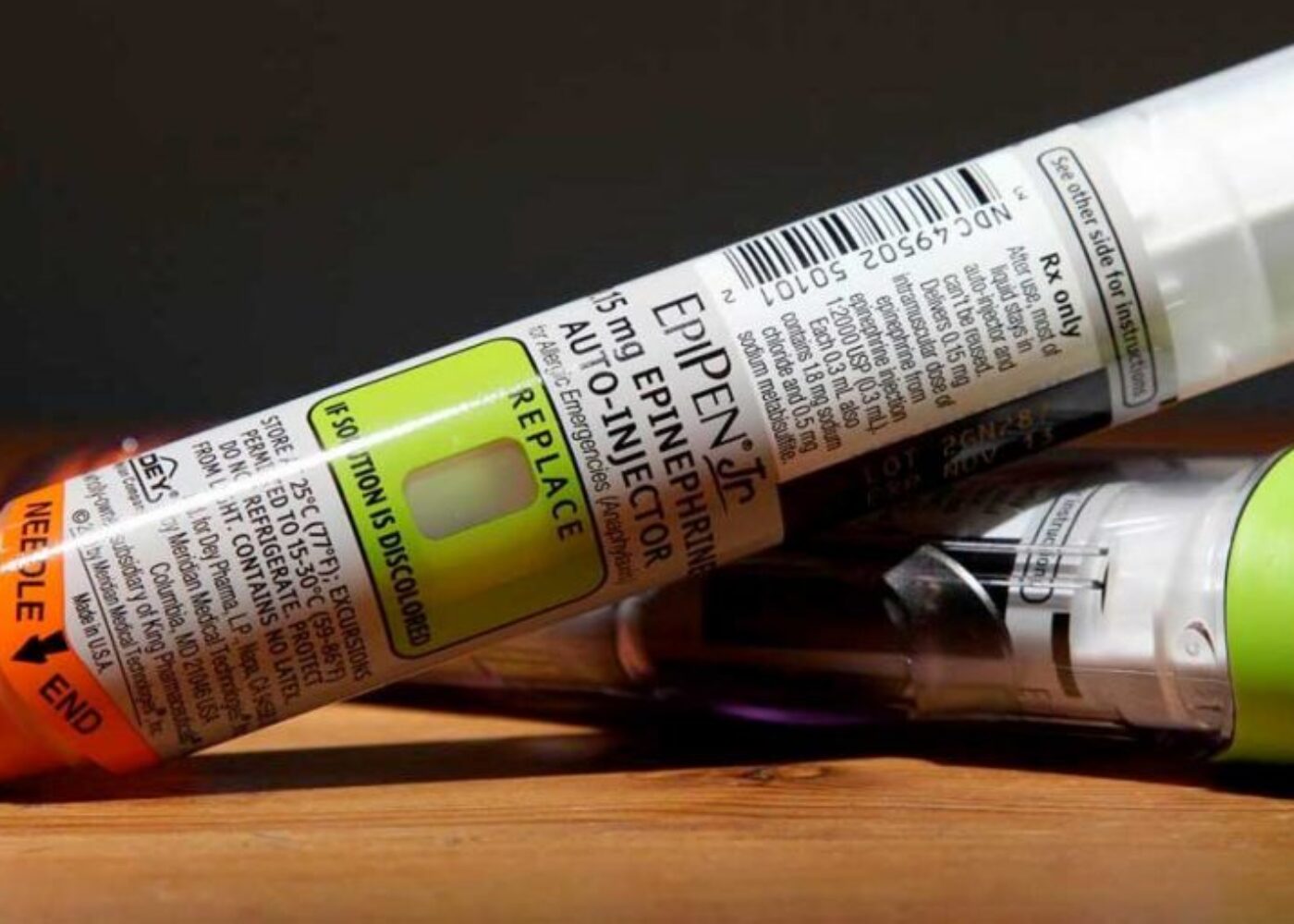Seven Reasons Why the Epipen Crisis is Grimmer than You Know

Guest article written for RobynObrien.com by Jill Negro.
By now, you may get a little sick to your stomach hearing about Mylan’s wrongdoings. Well, it is even worse than most media is likely aware of, and has reported. I am a mom of two boys who require Epipens for nut and egg allergies. They need, at bare minimum, one for home and one for school, each. We spend thousands of dollars on Epipens each year. Yes, this is with insurance. Yes, this is with Mylan’s “free Epipen” coupon. Yes, this is including the new “$300” coupon. Yes, our insurance does cover them—but, subject to our $5,200 deductible. Yes, this is typical of most families with food and other allergies.
I also happen to have a background in health insurance and am, unfortunately, intimately familiar with Epipen price gouging and its impact on the many families like mine. It is ironic that I am Mylan’s target market. And I am also the mom crying at the pharmacy because we can’t afford our children’s prescriptions.
Now that we got that out of the way, here are a few important facts you’ve likely not have read or known:
1. The patient assistance program does not apply to most patients. Mylan’s initial response to this crisis, and make no mistake, it is, indeed, a crisis, despite what Mylan would like you to believe, was to increase the patient assistance program income eligibility limit. I had a glimmer of hope. Until I read the fine print: “The patient must not have prescription insurance coverage through Medicaid, Medicare Part D, TriCare, a qualified health plan purchased on a state-based, partnership, or federally-facilitated Exchange, or any other public or private program or insurer. Verification documents will be required.”
Did you catch that? Mylan is touting the patient assistance program as an answer to the problem of patients and parents with high deductible health plans who can’t afford Epipens for themselves or their children—yet, people with any health insurance, high deductible or otherwise, are not eligible. Since the uninsured population is quite small these days, this “assistance” actually applies to very few (if any).
2. The new, $300 coupon, available for “certain people” expires in less than three months. Mylan has not said whether the coupon will be available beyond the December 31, 2016 expiration date or not. Are they simply hoping the bad press blows over by then? My own family won’t even be able to actually use the coupon because we need to refill our script in January, in order to get the longest time with our Epipens before having to shell out thousands more again next January.
3. The $608 wholesale acquisition cost you see in the media is actually hundreds less than what most patients are paying. Customers pay retail, not wholesale. According to many upset moms across the country I’ve heard from, the costs are now much closer to $800 and up. The Mylan CEO said very little to clarify this, other than indicating in a prepared statement that a “minority” of customers may have paid wholesale acquisition cost, or more. She did, arguably purposefully, not distinguish just how much more that cost really is.
When I last called our local pharmacy, they quoted $743 per box. In order to make sure we have coverage for both of my young kids at home, preschool, and activities we need four boxes, at absolute minimum, and realistically six, if we want to be sure there is one available at all times wherever they are. Next year, when my older son starts elementary school, I’m told that if he wants to play any sports another, separate Epipen is a requirement. If you’re counting, that’s $4,458 for the six boxes we need to keep my kids safe. This is a yearly expense.
Even if Mylan extends the $300 coupon beyond December, it still only brings us back to what we last paid in June, nearly $500 a box. And it is still thousands more than what my family, and most families, can afford.
4. When the $300 “generic” Epipen comes out, no one knows how, or if, it’ll be covered by insurance. Also, for the majority of families who need multiple Epipens for multiple children, this is still thousands of dollars. In addition, it is an extremely high price for a “generic,” off-patent drug. By all accounts, we are talking about a very old, dirt cheap medication housed in a device created by government funded dollars 40 years ago.
Mylan continues to cite “increased awareness” as a reason for their astronomical increases: But is it awareness or advertising? I certainly did not need to be made “aware” that my 11 month old broke out in hives at a restaurant, or that my nephew had trouble breathing after a mild exposure to peanut residue. Our allergist was prescribing Epipens long before Mylan acquired the drug from Merck. They cite increased Epipen prescriptions as proof of this “awareness” without noting that the prevalence of food allergies in children has also been increasing to now 1 out of 4. This is a statistic that Mylan is capitalizing on.
Bresch also loves to talk about the “free Epipens for schools” program, although it does nothing for families who have children with documented allergies who are required to have their own, current prescription, in their own names, in order to even be able to attend school. As Senator Blumenthal indicated in his press conference, you can’t require schools and parents to purchase Epipens and then price gouge them on it. He correctly noted that Mylan is taking advantage of the 2013 law that they lobbied for. While I am certainly happy that schools must stock emergency Epipens, and that they must provide staff training, subsequently increasing the Epipen cost beyond what my family can afford is forcing us to choose between our children’s most basic needs and their Epipens. What would you choose?
Additionally, the “enhancements” to the device mechanism, basically that the needle is covered after injection, has turned out to likely be a minimal investment, according to experts.
Mylan also states they’ve had costs from researching how to extend the shelf life. And lo and behold, they’ve been successful in doing so…but why did it take a congressional hearing for anyone to even hear about this breakthrough?
5. The shelf life for the actual patient is 4- 6 months less than what Heather Bresch admitted, under oath. In the congressional hearing, Bresch stated that the shelf life is 18 months. What she neglected to clarify is that by the time patients pick up an Epipen from the pharmacy, there are usually only 12 of those 18 months left, sometimes less. I’ve never gotten more than 13 months out of our Epipens, and I always ask for the latest expiration available. I feel Mylan intentionally misled congress by saying 18 months and not disclosing the lag time between when the Epipen is manufactured, and when we can pick it up, leaving us one year. In fact, I have a friend who recently only had 6 months before having to buy new Epipens for her 2 year old son.
6. This direr crisis applies to the majority of people with life-threatening allergies. A huge point of frustration for many moms in food allergy networks across the country is Mylan’s insistence that “most” people get Epipens for $100 or less, or even free. In fact, Mylan likes to estimate 85% of consumers, yet no one knows where this number is coming from, or how it could possibly be true. It is certainly not true for the vast majority of my friends’ families, nor the majority of moms I’ve spoken to who are crying out for help. It also does not take into account the many people who leave their Epipens at the pharmacy because they can’t afford them. I alone have three friends who have sadly done just that. They are taking a gamble on their lives. All three are moms.
Importantly, there are also most likely many people who simply wait to fill Epipens until they’ve met their $5,000, or $6,000, or $10,000 deductible. I’ve done this myself. Why? Because we can make payments to our doctors and hospitals. Epipens require thousands of dollars of cash, up front. Why is this important? Because many of us are keeping expired prescriptions at home until we meet those deductibles, or until we can afford to buy more. And again, this puts our children’s lives at risk. The situation is much grimmer than Mylan would like you to believe: My friends and I are risking both our and our kids’ lives—because we simply have no choice!
Further, even if your Epipens are well-covered by your insurance plan that cost is most definitely coming back to you, whether you realize it or not, or whether Mylan admits it or not.
7. Bresch testified, falsely, under oath that the increased cost to insurance plans for people who are lucky enough to pay only a copay for their Epipens would not subsequently come back to consumers with an associated increase in health insurance premiums. That is exactly how insurance works: Healthcare costs go up, premiums and rates go up—or cost sharing, i.e. deductibles and coinsurance and copays, go up. While I do have 10 years of experience in health insurance, this is not exactly an industry secret, but common knowledge, which also happens to be frequently reported on. Did Bresch really not know this as CEO of a major drug corporation?
Let’s give the benefit of the doubt and simply think about it for a minute. What happens if you’re in a car accident? Multiple car accidents each year? Do your car insurance premiums go up or down? Do people purposely avoid putting in car insurance claims to avoid an increase in their insurance costs? Why, yes, they do. Having multiple children with food allergies who require multiple Epipens per year is like having 4-6 accidents per year, every year, year after year…most likely for the rest of their lives. Except what just five years ago was the equivalent of a fender bender, is now like being rolled over five or six times per year by a Mack truck, through no fault or choice of one’s own.
To be fair, while having one, or even a few, increased costs won’t necessarily cause a sole individual’s premium to go up, higher claim costs DO cause increases in premiums; it’s just that it’s not only for you, but everyone covered under the plan–most especially since these are predictable, yearly expenses. Does that make price gouging better? No. It simply means we are ALL paying. And some of us twice because we are also taxpayers paying for services such as Medicare, Children’s Health Insurance Programs (CHIP), and Medicaid. How do you like them apples? Are you outraged, yet? Because if you’re not, you should be.
Offering a $300 “generic” for some, while forcing others—insurers and the government—to pay $700-800, absolutely causes premiums and rates, and/or copays and deductibles, to go up for EVERYONE. The insurer will not simply absorb that cost increase out of the kindness of their hearts. After all, they’re indebted to their shareholders, too. And do you suppose that any company in America can, and would, and even should, absorb the skyrocketing cost from blatant price gouging? Would you be happy to know that if not passed onto you, it must come from somewhere else? Perhaps your bonus? Perhaps your salary? Perhaps your job? Or would you like to instead sacrifice your child’s life?
What options do we have? I was recently invited to share my family’s story on Dr. Oz, and he talked about one alternative: generic Andrenaclick. As you can see, GoodRx coupons for Walmart are, hallelujah, currently about $144 per box. However, this appears to be without insurance. If I’m paying about $700 out of pocket, I would want it to be applied to our deductible so that it is not an added cost on top of the $5,200 we pay out of pocket, but it’s still clearly a huge relief and improvement over paying $4,000 or more all at once. And while it’s unclear at this point if the generic Adrenaclick is an option for our family, since I need to talk to our doctor, you better believe I don’t want to give Mylan any more of our money.


